After losing the first matchday of Brazil’s 2022 Série A, Internacional made the controversial decision to sack Uruguayan manager Alexander Medina. Only winning six of their first 17 matches of the season, the Porto Alegre side decided, prematurely in many people’s minds, to change directions.
Medina’s replacement, Mano Menezes, is a traditional Brazilian manager with nearly 20 years of managerial experience. This decision was cause for concern, as the strategy behind appointing Mano was the complete opposite of the one adopted a few months earlier. Nonetheless, in hindsight, it proved to be the correct one.
Menezes is considered by many an outdated manager in Brazilian football, similar to the way former Everton and West Ham manager Sam Allardyce is viewed in the Premier League. That general perception, however, has proven entirely inaccurate. Now a very difficult team to face, Internacional currently sit sixth in the Série A battling for Libertadores qualification.
The 60-year-old manager has introduced organisation and stability to Beira-Rio. With transitional play and purposeful possession, Internacional have one of the best attacks in Série A. Most notably, they have recently defeated current champions Atlético Mineiro 3-0 and Chile’s Colo Colo 4-1.
In this tactical analysis, we will examine the tactics behind Internacional’s recent success under Mano Menezes. This analysis will not only explore the structure through which they play but also their behaviour with and without the ball.
Formations
Though there are a few key players Mano Menezes tends to constantly change in his starting eleven. Internacional’s squad is relatively diverse, with players having different individual characteristics. This proves essential, as Mano is a manager who likes to adapt to opponents. Additionally, players like former Shakthar Donetsk duo, Alan Patrick and Taison, have been in and out of the squad due to injury. Brazil’s exhausting schedule has been another factor behind this rotation.
At any rate, Mano is a very adaptable manager. Consequently, as seen below, the formation is constantly changing. The 4-2-3-1 has been the most used shape, but even then, the in-game structure will vary depending on the players. Other formations like the 4-4-2, 4-4-1-1, 4-3-3, and others have also been used.
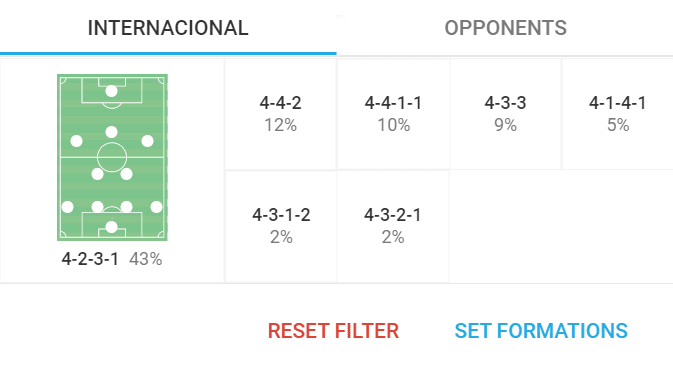
The overall structure, though, is usually very narrow. Under Mano, Inter’s width is often maintained by the fullbacks while attacking players will overload the central lanes. Additionally, there are a few key players worth mentioning.
Fabricio Bustos has been the go-to right-back, especially after Heitor’s departure to Cercle Brugge. While Gabriel Mercado and Vitão tend to be the centre-back duo, others have also featured. The midfield trio of Gabriel, Carlos De Pena, and Edenílson are essential to how they play and is perhaps the most solid part of the team. Finally, their forwards have very distinct characteristics, but Alemão has been Mano’s trusted number nine.

Conscious possession
Internacional are certainly not a possession-based side, with the seventh-lowest average possession in the league at 47.4%. Their 10.96 shots per 90 further highlight this lack of volume, with it being the sixth lowest in the league. Nonetheless, they have one of the most effective attacks in the Série A. For starters, they have the third-highest xG in the league (31.71), and their 30 goals scored is the fourth-best. Additionally, they reach the opponent’s penalty area quite often at 16.1 touches in the penalty area per 90. Finally, their 83.29 ball losses per 90 are the lowest in the league.
These key metrics illustrate their strategy in possession, depending not on volume, but on effectiveness. With the ball, there is one overarching objective, which is to create transitions. As a consequence, they are conscious and purposeful in possession. Their verticality is carefully dictated, and so is the focus of attack. To further understand this, it is important to start with the build-up.
Colorado, as they are known, build up in a 4-3 structure. While Gabriel starts off as the single pivot with Pena and Edenílson ahead of him, they will often rotate amongst themselves. Fabricio Bustos, the right-back, starts slightly higher than the right-back as he is very dangerous going forward.
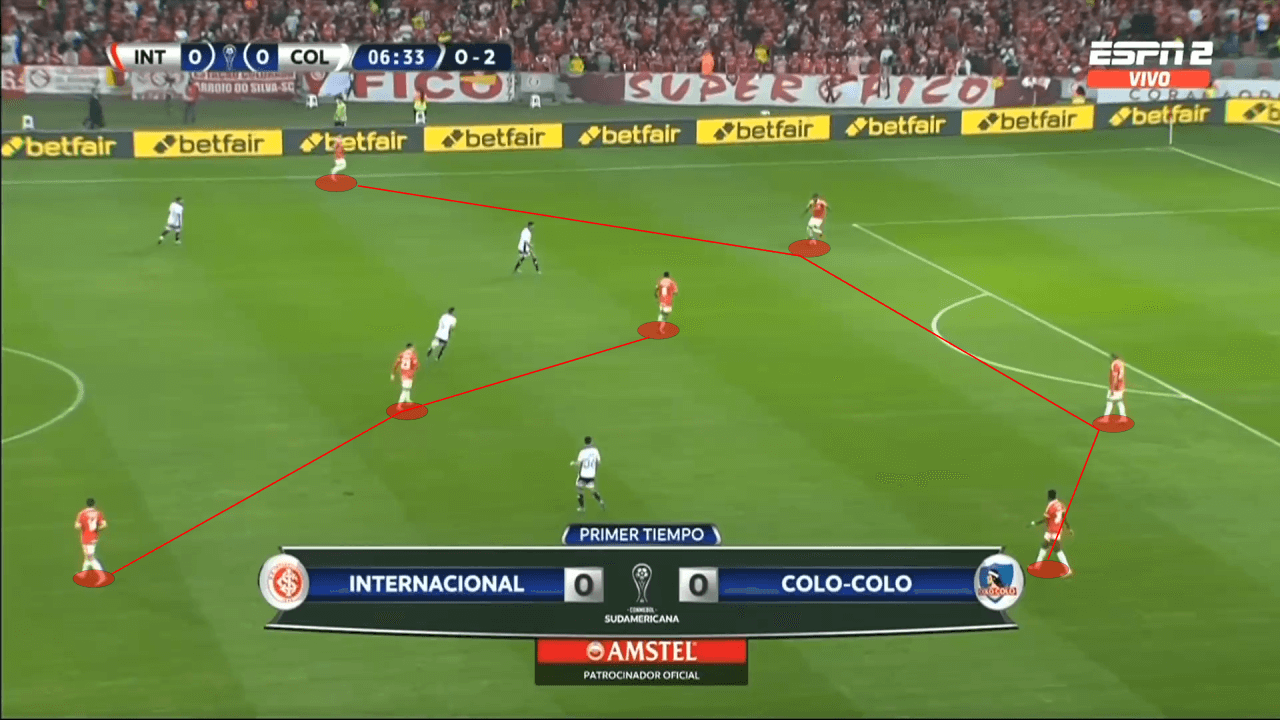
By using seven players in the build-up, they attract a significant amount of opposition players into their third. With the forwards pinning the backline in the midfield, they are able to create space for transition-like scenarios.
Against Atlético, a specific example can be looked at. Initially, they are in their asymmetric 4-3 shape. Mercado immediately plays Vitão to his right and focuses the build-up on that side.
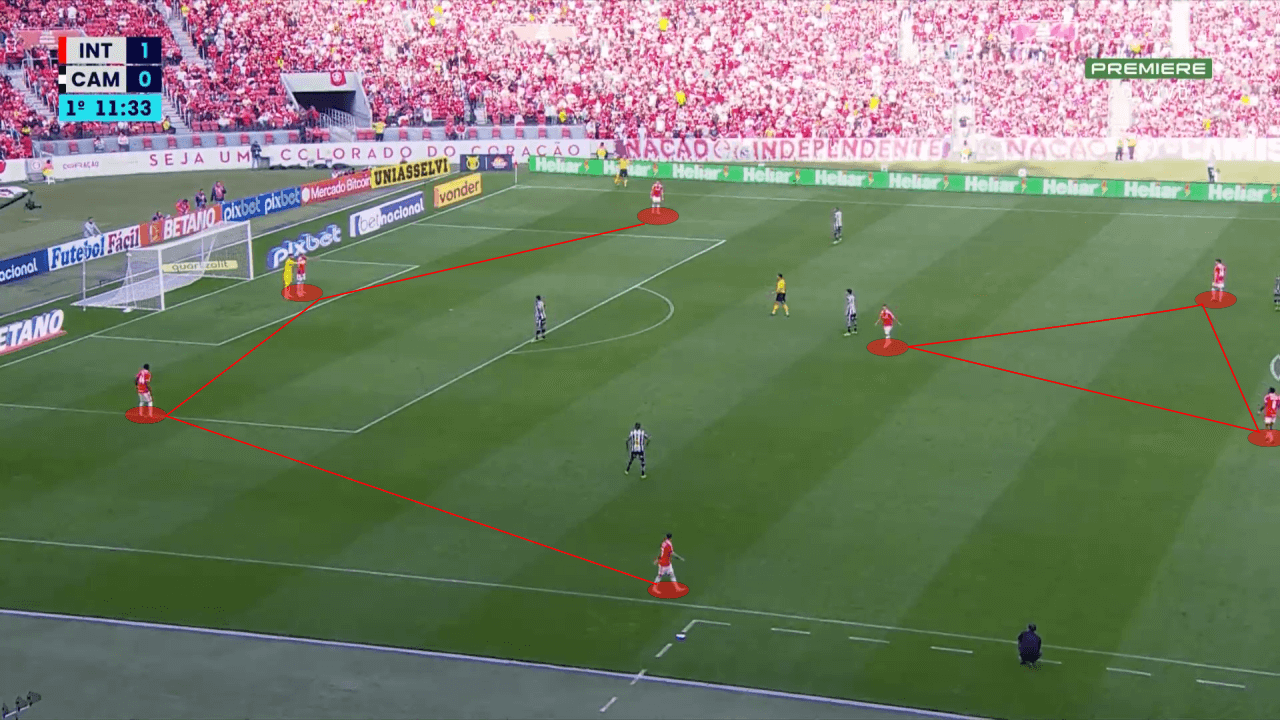
With Gabriel coming to support, Atlético commits six players forward. As mentioned, the backline is pinned, so space is created entering the middle third. Alemão is able to drop into this space and receive the ball with time and space.
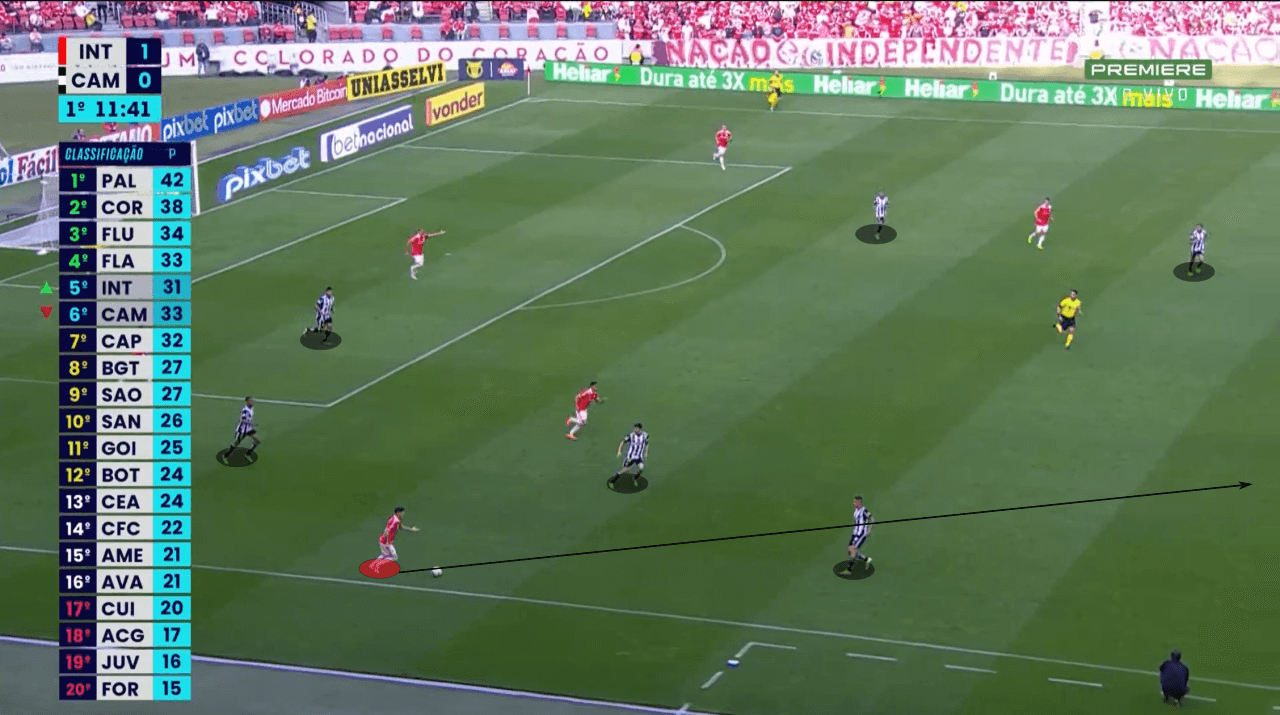
Their plan of luring the opposition in to create space is successful, and a transition-like scenario is created. With Atlético scrambling to reorganise their defensive structure, Alemão switches the focus of attack to make it even more difficult.
The directness of their passing is purposeful. First, it is short to lure the opposition in. Once space is created, it becomes longer. The switch of play is also conscious. If Alemão continues on the right side, it is easier for Atlético to recompose as their players are already there. By switching it, however, he puts Atlético in grave danger.
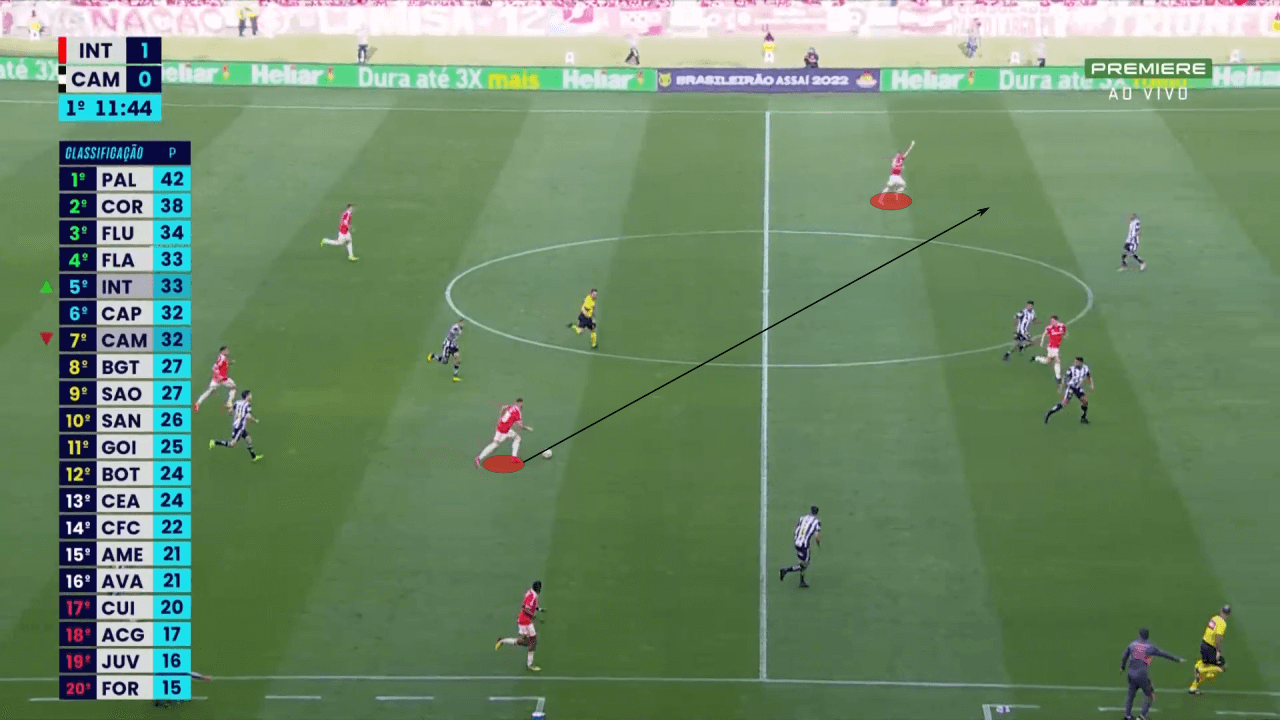
Switches of play are quite common under Mano, even when breaking down a low block. By forcing the opposition to quickly shift their entire defensive organisation, spaces and chaos is created, even if it is for just a few seconds. At any rate, Colorado have been very good at taking advantage of this chaos.
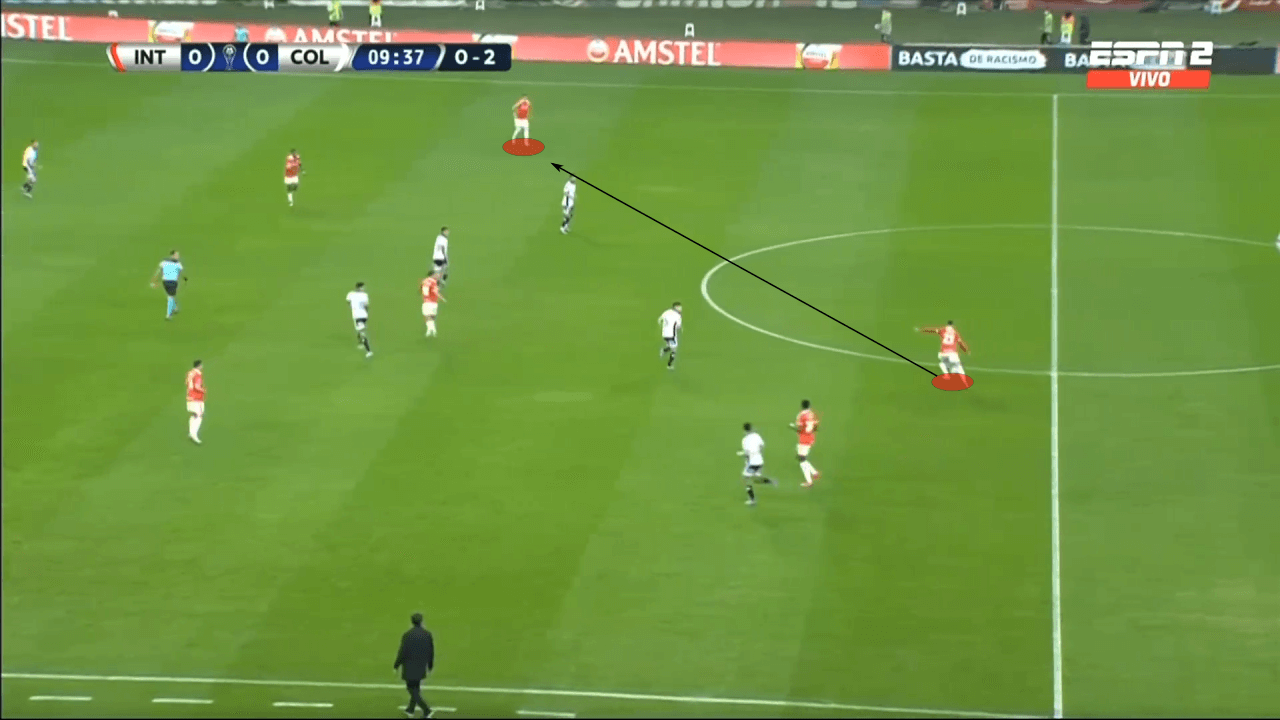
The midfield trio is the heart of the team, with a significant role in all phases of the game. At times, like in the example below, they will be very close to each other and take advantage of quick combinations to progress.
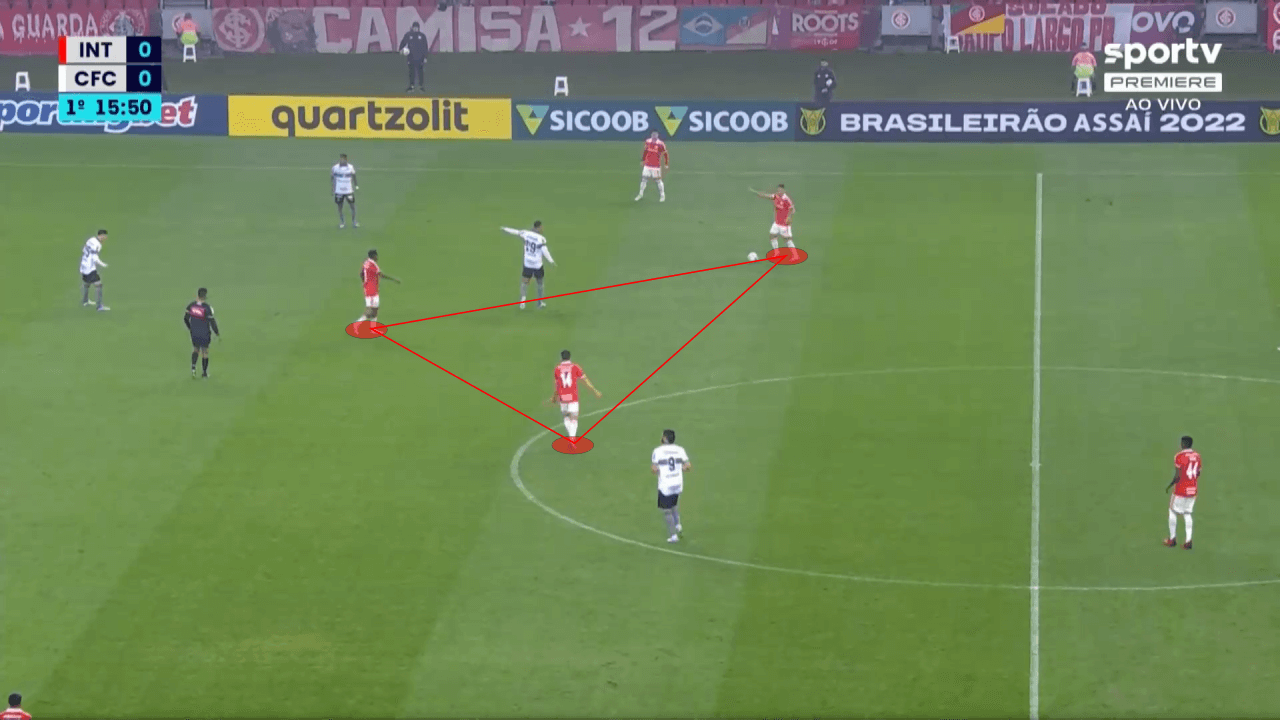
On other occasions, they will be quite far apart and stretch the opposition’s organisation. In the example below, despite being far from each other, they are able to connect out of pressure and progress out of the middle third.
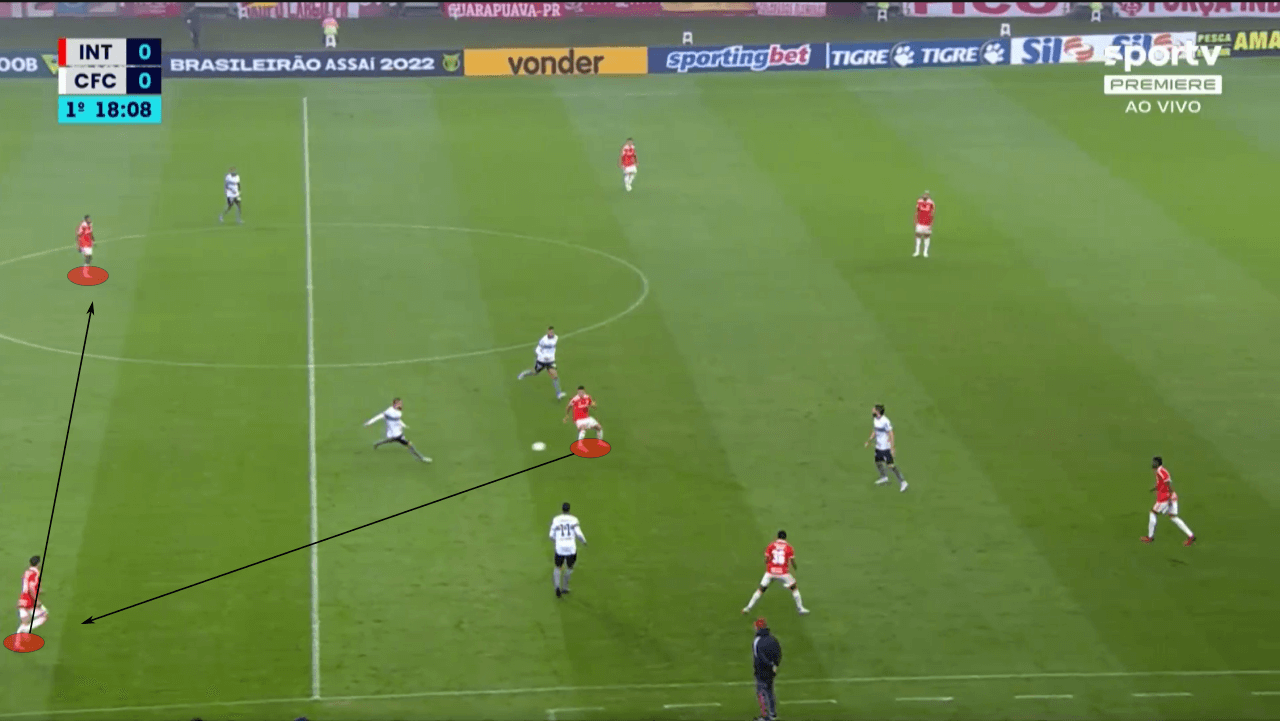
Finally, Vitão’s role in possession must also be highlighted. On loan from Shakhtar, the 22-year-old centre-back is a promising ball-playing defender. In 2022, the Brazilian averages 5.02 long balls per 90 with an impressive 62.4% accuracy. In a team that likes to use verticality to exploit the opponent, this is crucial. Against Colo Colo, Vitão completed 11 of his 12 attempted long balls.
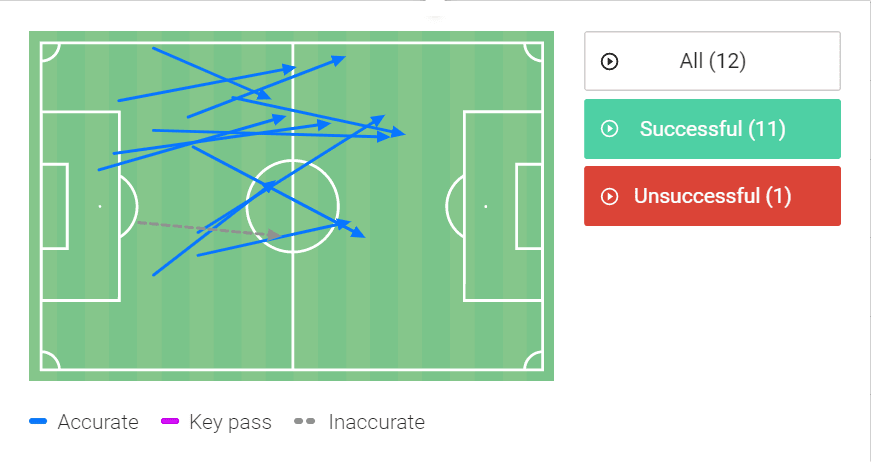
Transitions
Internacional are very much a transition-based side. As just explored, in possession, Colorado attempt to create these scenarios and exploit a disorganised defensive structure. As expected, their work in the offensive transition phase of the game is incredibly dangerous.
This work begins immediately after recovering the ball. Mano’s team have an incredible ability to quickly connect out of pressure and launch these counterattacks. Despite Atlético’s counter-press, they are able to pass out of their third and reach the space behind the press.
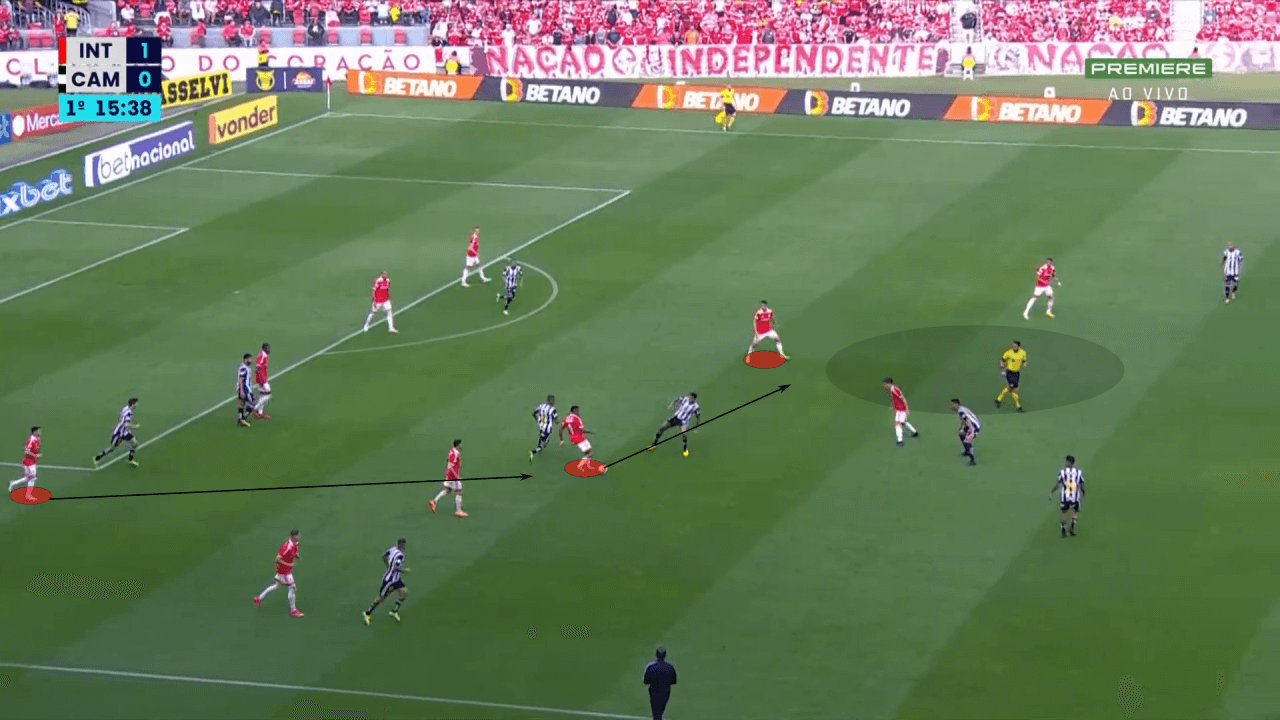
The objective is always to find these spaces upon recovering the ball, and Edenílson plays a significant role in doing that. The number eight has incredible awareness in the midfield and is the outlet before the outlet. Among the chaos, Inter try to play to him in order to find their way out.
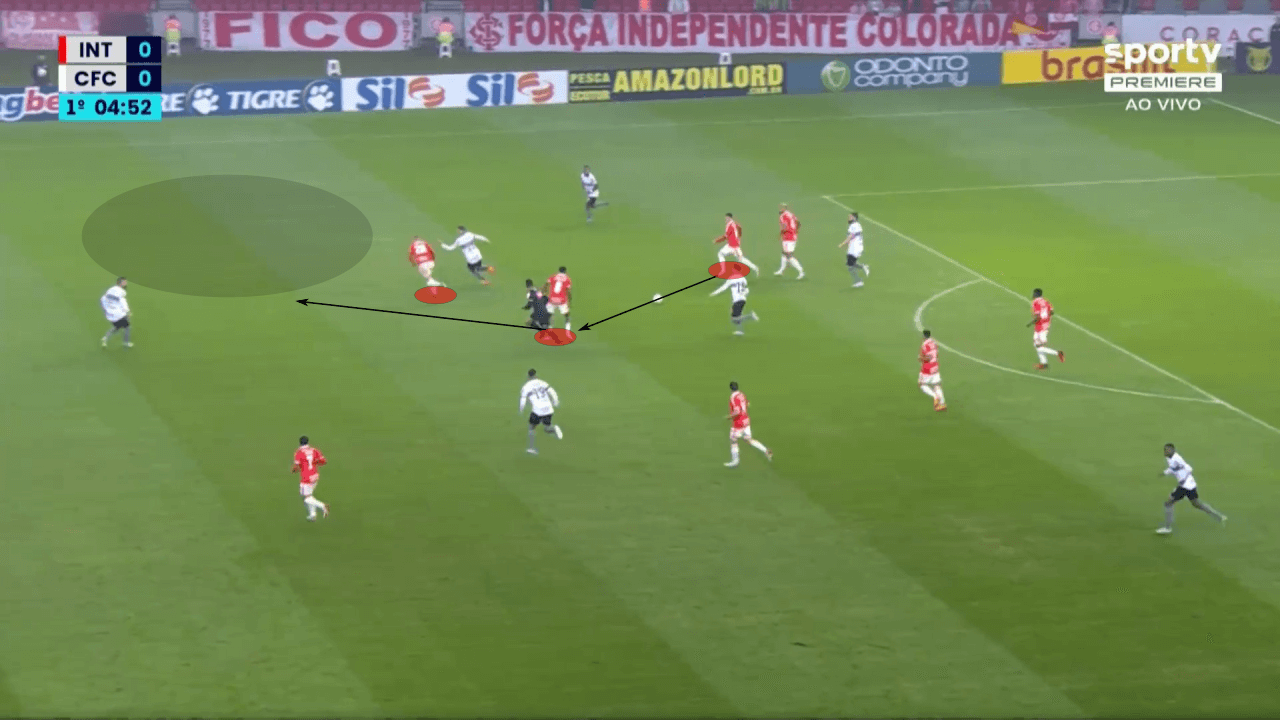
Coordinated movements and combinations are other resources used to find their way out. Players will move off the ball, thinking two steps ahead. In the example below, as Pena finds Alemão, Maurício approaches him to receive a lay-off. As this is happening, Wanderson is making a run on Alemão’s opposite side to receive a through-ball from Maurício.
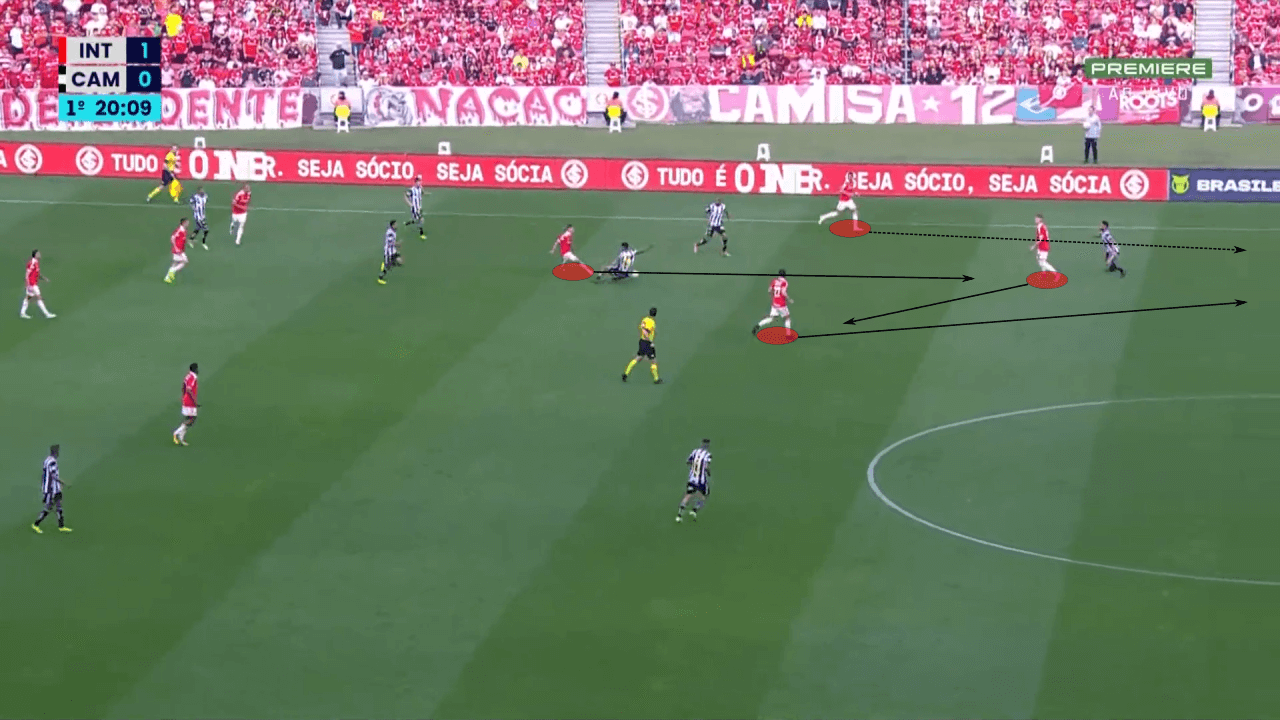
In this other instance, Pedro Henrique makes a selfless inward run to bring the defender with him and create space for Pena to attack. Their movements in transition are well-coordinated with the objective of exploiting a disorganised structure.
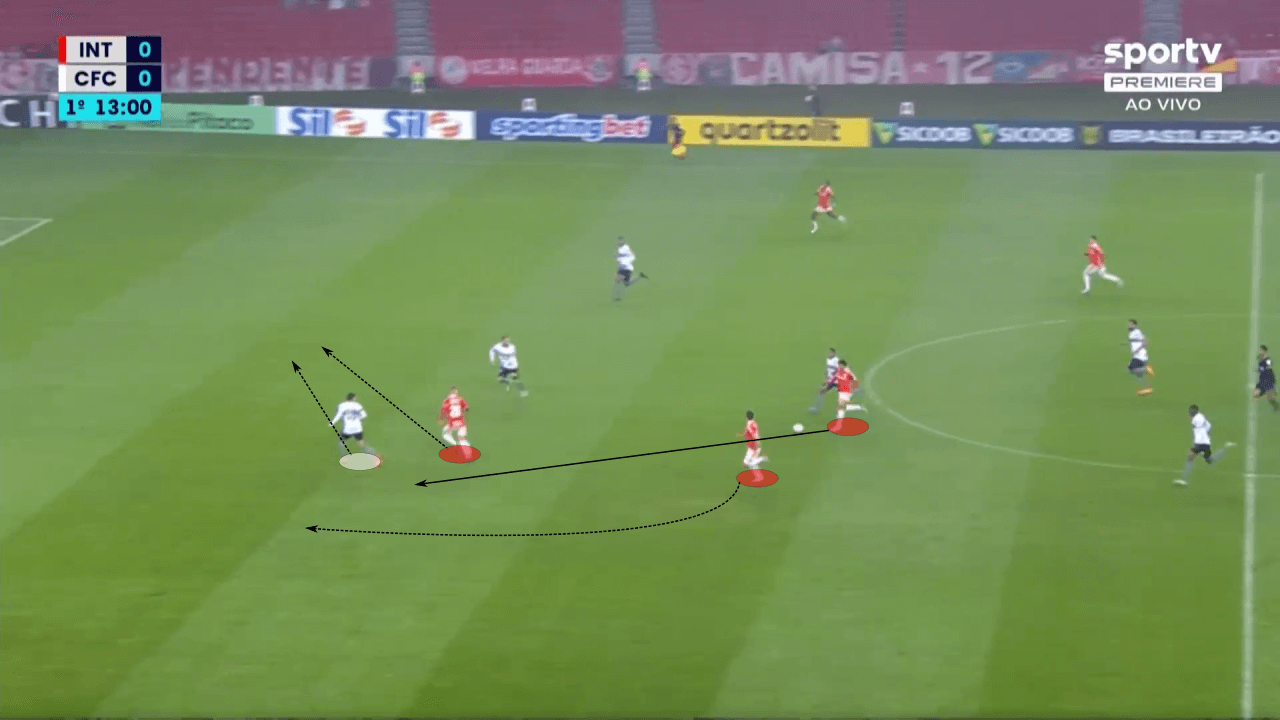
It is also impressive the numbers through which they counterattack. Mano’s men will collectively launch forward and overload the defence. In the example below, six Internacional players arrive in the final third compared to Atlético’s five.
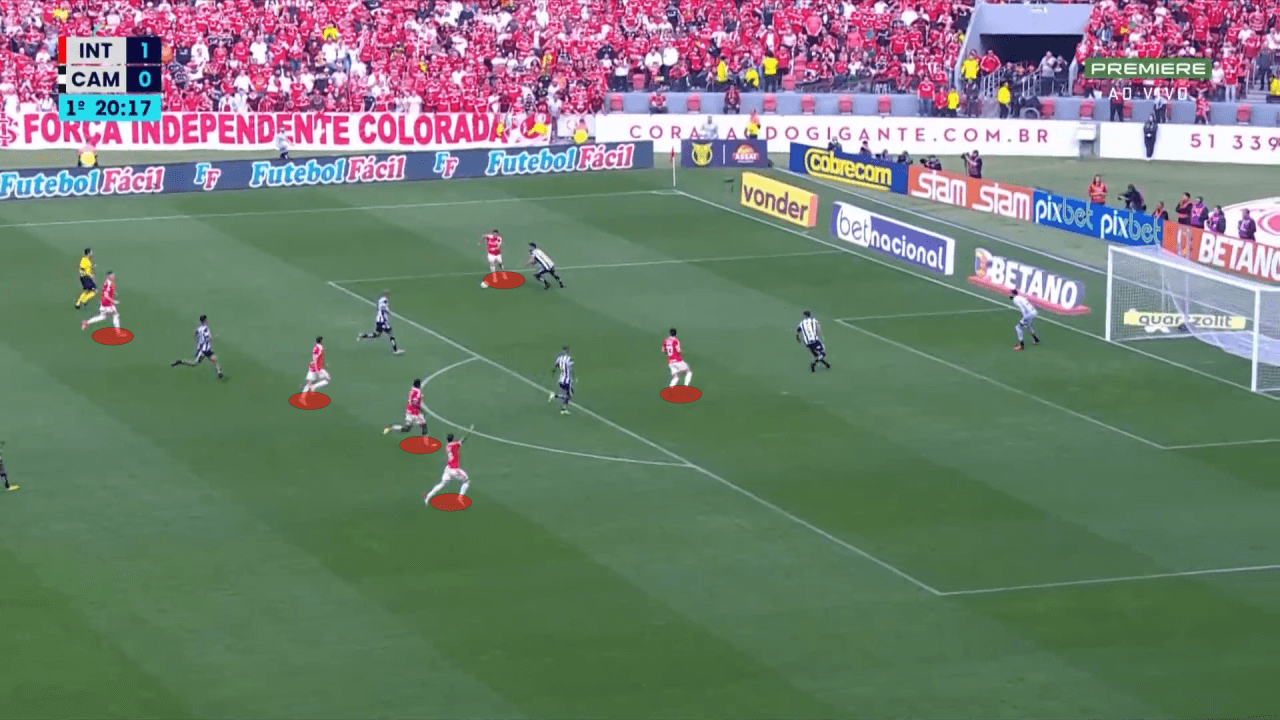
Defensive organisation
Defensively, Mano Menezes has a rather adaptable approach. Their aggressiveness, or passiveness, will depend very much on the quality of the opposition. Overall, however, the 60-year-old manager opts for a more cautious approach. Internacional’s 12.15 PPDA is the 17th highest in the Série A, and their 5.3 challenge intensity is the third-lowest. For the most part, Colorado tend to be on the passive side without the ball.
Against weaker teams, they will deploy a high press in order to dominate the game. However, this is quite rare, especially since their most effective offensive work is transitioning from deep. Against América Mineiro and Goiás, for example, they had a PPDA of 4.53 and 8.84, respectively.
On the other hand, and much more frequently, they are comfortable sitting deep for long periods of time. Against Flamengo, for example, their average PPDA was 18.95, reaching as high as an unbelievable 85 in the last 15 minutes of the first half.
Nonetheless, in mid and low blocks, they are very organised. The space between the lines tends to be minimal, with the overall structure being very compact. If opposition players do venture in between defensive lines, they are quick to close them down. Below, as Hulk drops in to receive the ball, Mercado immediately follows him while the other two defenders provide cover.
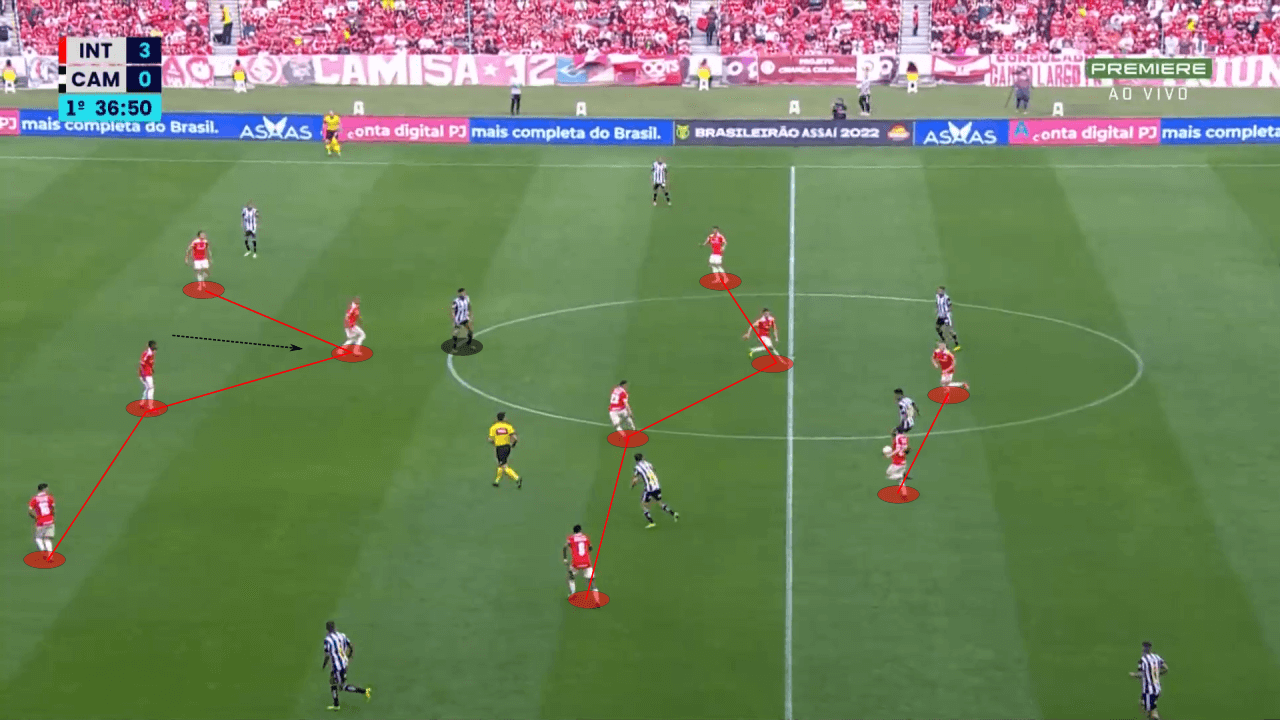
In a low block, they will revert to a compact 4-4-2. The wide midfielders are in charge of providing defensive support in the wide areas. Mano usually plans accordingly and puts a more defensive player on the opposition’s more threatening side. Against Atlético, Edenílson was in charge of helping eliminate Keno’s contribution.
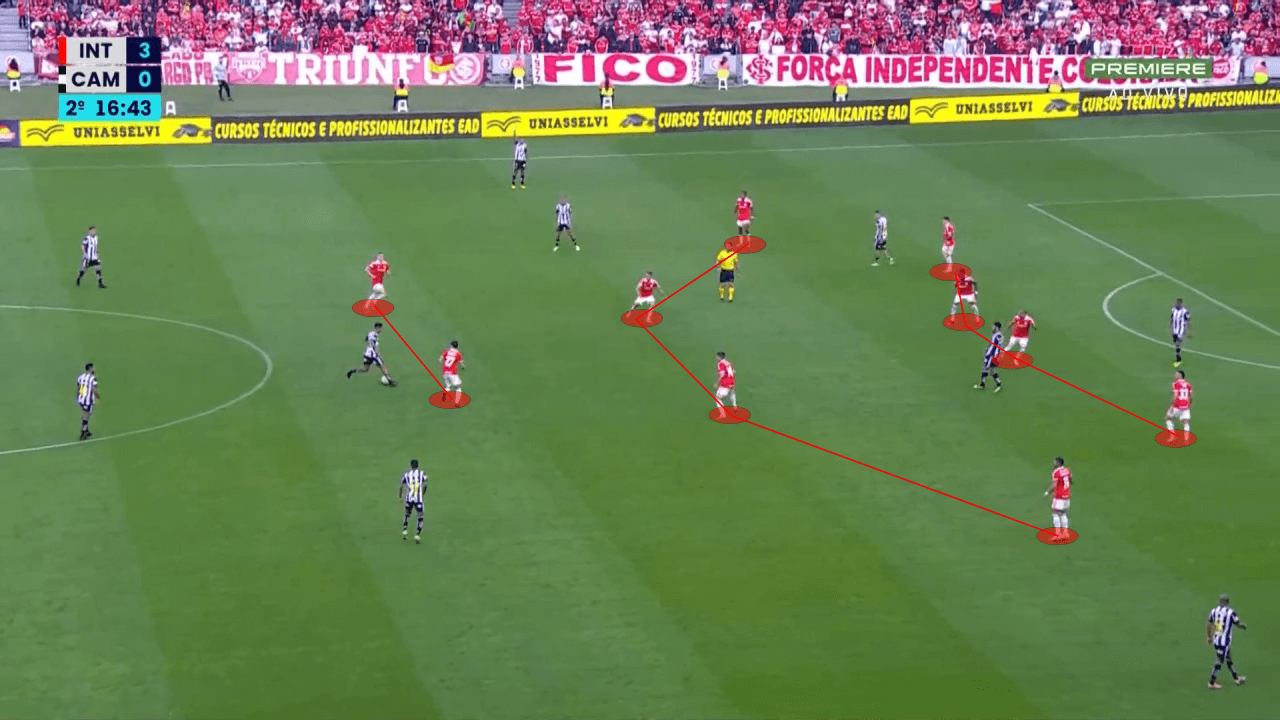
As the opponent gets close to the goal, they will drop even further and concentrate a significant amount of players around the box. When Mano’s men revert to a low block, they are extremely difficult to break down.
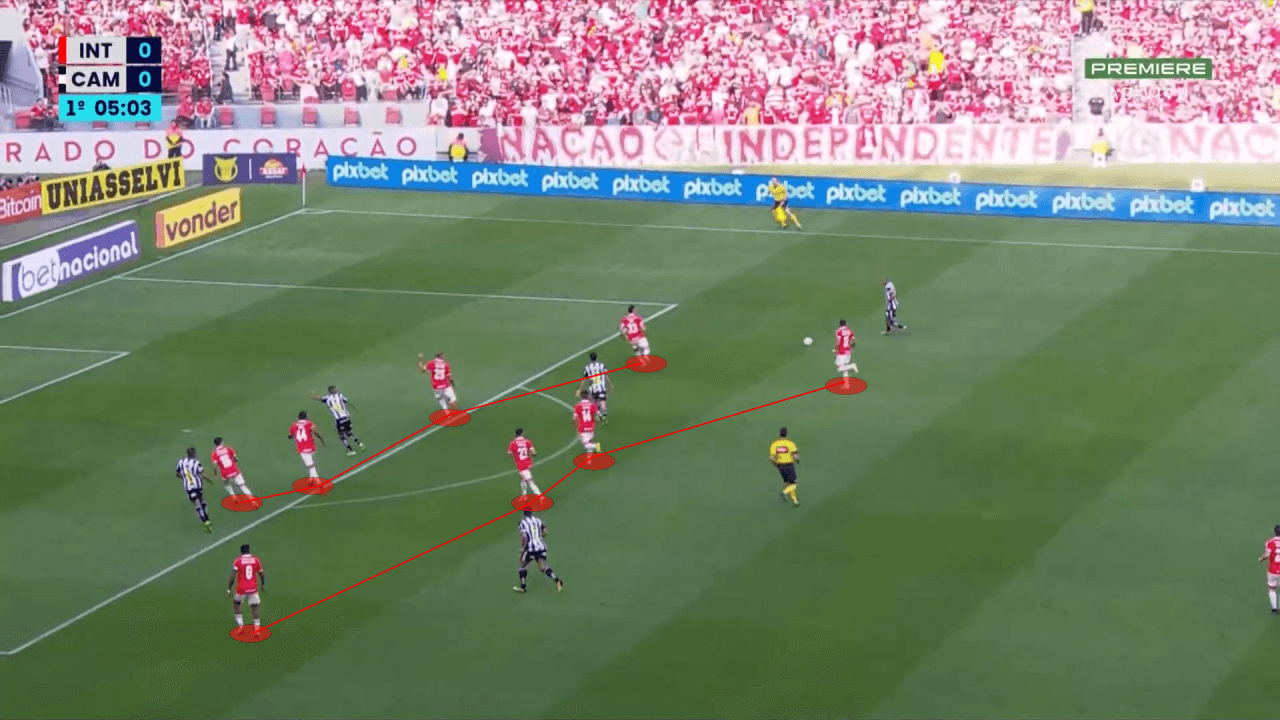
Against Athletico Paranaense, their behaviour in a low block can be further explored. As the two wide players protect the left side, where Athletico’s player has the ball, the rest will sit in a compact structure in front of the box.
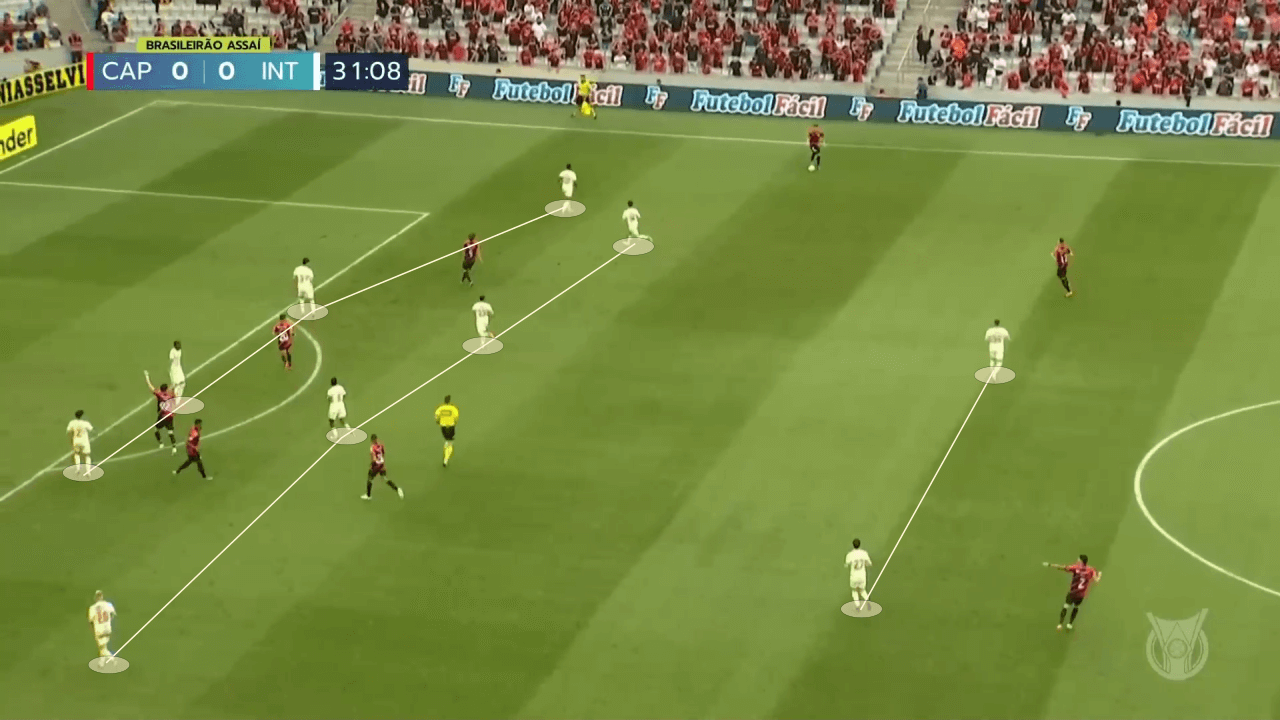
Conclusion
After a rocky start to 2022, Mano Menezes introduced order and stability to Beira-Rio. Through a passive yet secure defensive system, Internacional is able to comfortably defend for long periods of time before exploiting the opposition in transition. Even in possession, Inter try to lure the opposition in and create transition-like scenarios to exploit a disorganised structure.
While some may not find Mano’s tactics attractive, they have certainly proved effective. Internacional currently sit sixth in the Série A, hoping to achieve Libertadores qualification at the end of the season.





Comments